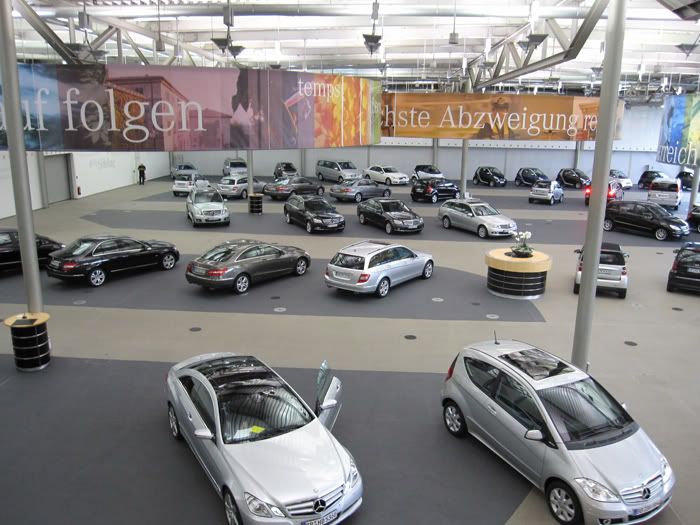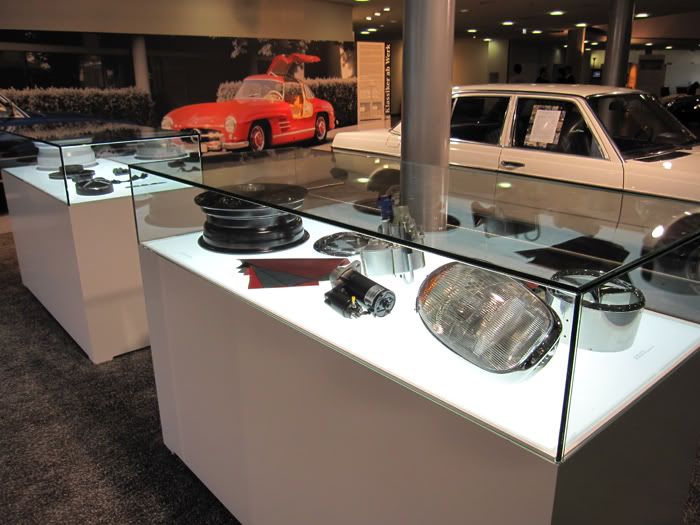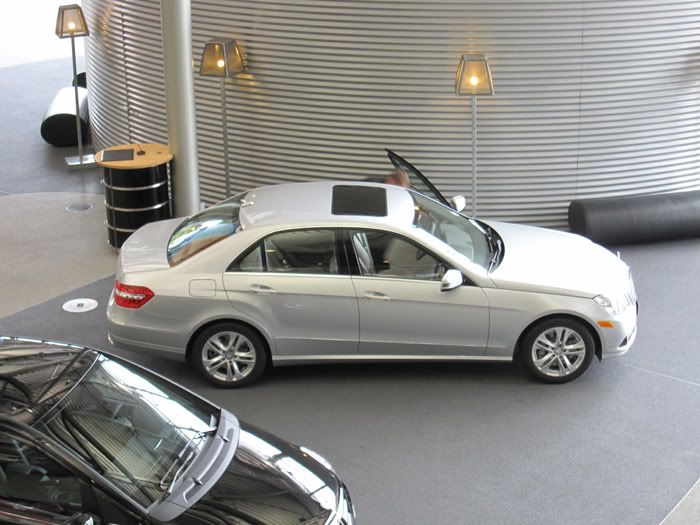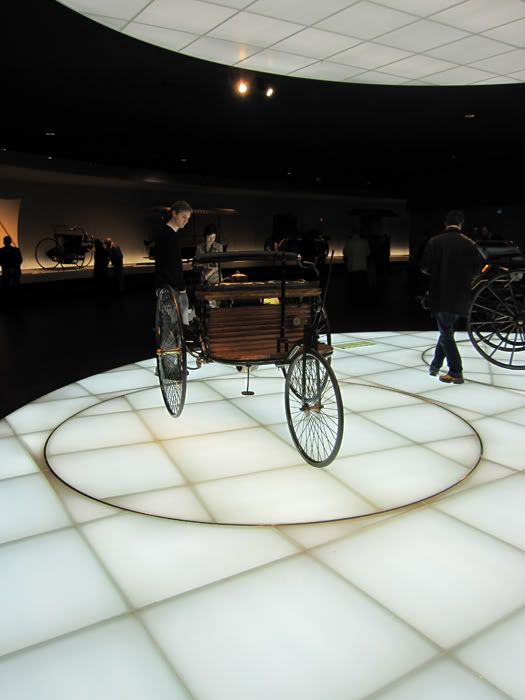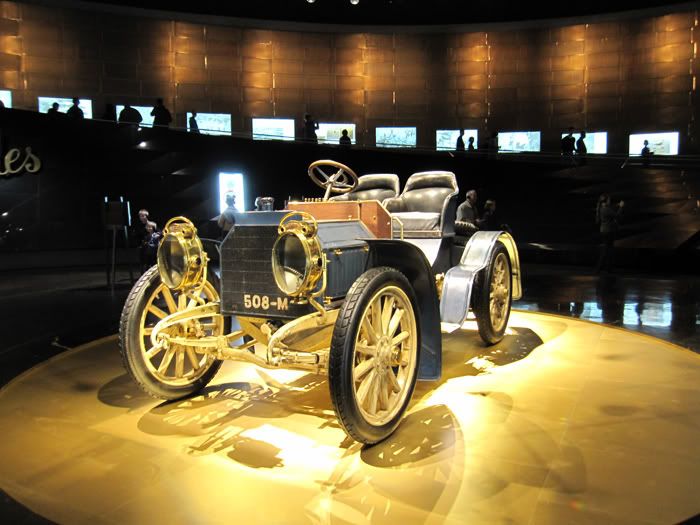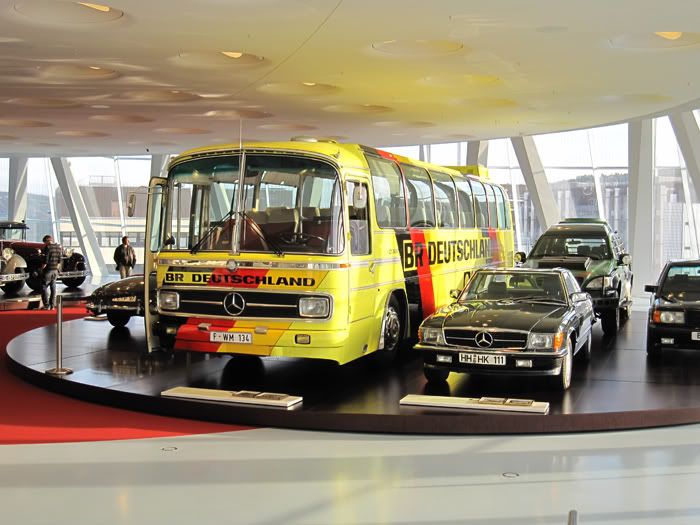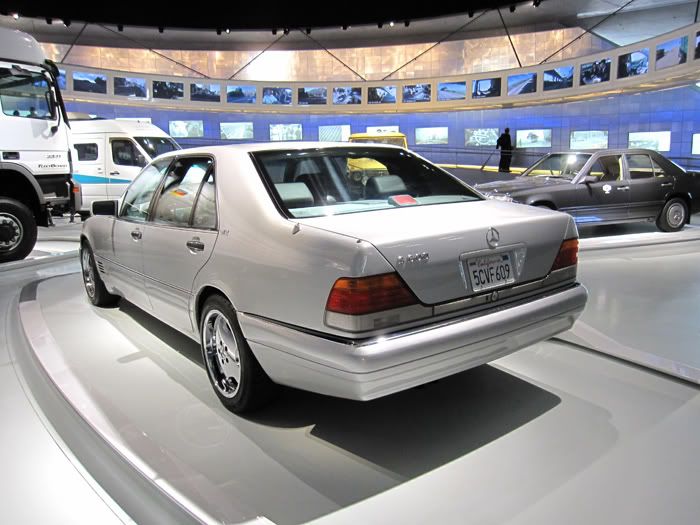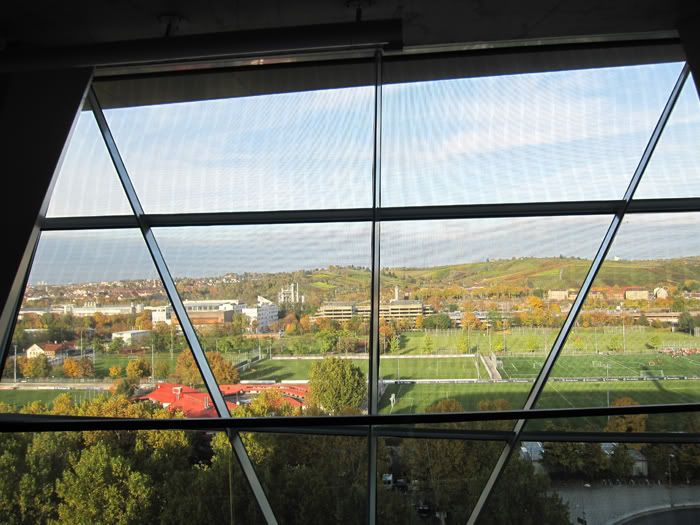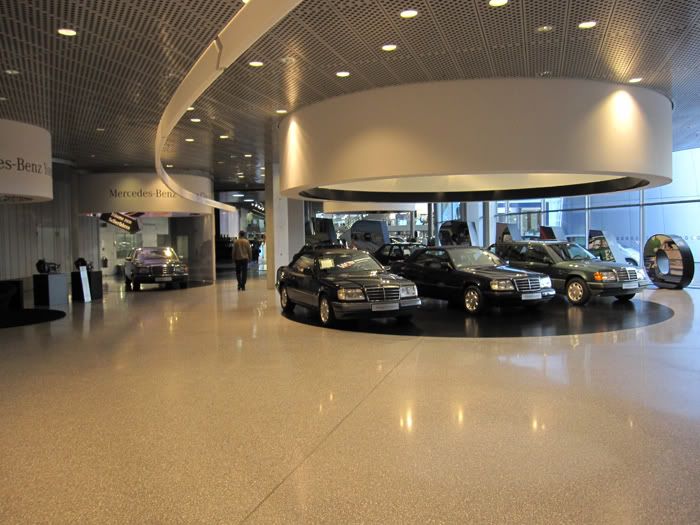Updates halted again as I spent some time here and there, including back in Tucson for the first real time since I was forced to leave in my poverty days. But for now, I want to continue my European travelogue.
This post goes back to the big day - Tuesday, October 27th, the day I took delivery of the Mercedes-Benz. Although Mercedes-Benz USA advises a three-month lead time for European Delivery orders, I was able to secure a delivery date with only a 2-month notice, thanks to ordering the most common color - silver. And this was going to be a LONG day that would really involve anything/everything Mercedes-Benz. This may be the one post on this blog that will come the closest to being a Mercedes-Benz commercial.
The Customer Center ("Kundencenter" in German) is located at the main Mercedes-Benz factory in Sindelfingen, about a 30-minute taxi ride away. I had to take a cab ride, paid for with a Mercedes-Benz voucher. Interestingly enough, the cab itself was a previous E-class, with cheaper interior and a diesel engine. The cab ride, had I paid out of my pocket, would've been €45 plus tips - NOT cheap. The ride took me on Bundesbahn 14, proceeding through city streets and through a LONG tunnel (complete with an intersection in the middle) before taking me on to Autobahn 831 and 81; although 831 and 81 were Autobahnen, they were hopelessly congested construction zones, and speed limit was set at 100 km/h anyway.
My Kundencenter arrival time was around 8:30 AM, and after check-in, I had to wait for a while due to extra paperwork required for a US-market car.
The delivery bay is a very pleasant place, as I am finding out while having a continental breakfast on an upper-level terrace. Factory delivery is a popular option for European owners of Mercedes-Benz vehicles; they show up, take delivery, and take the leisurely drive home. But occasionally, North American market models show up here as well, for Americans and Canadians who want to come to the factory for the car, then use the car for some European sightseeing. North Americans, for obvious reasons, are not allowed to take delivery of models that are built only in North America, such as the M-class and the R-class.
This huge space has cars coming in and leaving constantly. Despite the exhaust, I am not feeling anything - the ventilation system here is robust. And despite all the amount of airflow required, I am not feeling even a hint of a breeze inside. I do airflow for a living, so I had to take note of this.
I am loving this place. It has all the feel of a nursery for newborn babies, complete with brightly colored banners. The "babies" here are brand-new cars waiting to meet their owners for the first time, of course. All the cars have been built to order, so they were spoken for before they were ever scheduled for production. This place is really designed to bring out the maternal instinct in the owner - there is a reason why according to my saleswoman, women love European Delivery more than men do.
I'm still waiting, walking around a merchandise store and other displays introducing various Mercedes-Benz products and programs.
This display showcases the Young Classics program, which restores, sells, and services vintage Mercedes-Benz models. The 1982 model in the back is a good example of cars available under this program. The front display has various OEM parts for 1970s models - and they are all still available via the Young Classics program.
If it turns out that the relationship my mother and I start on this day with the E-class end up stretching for a LONG time, it looks like I won't have trouble getting parts and service. After all, Young Classics has a US showroom too - in Irvine, California.
I'm still waiting to do the paperwork, but I am seeing this silver E-class come in. The front side amber reflectors indicate that this is a North American model. I also noticed the red-striped export plates as the car came in. It may as well be the car that I am here to pick up.
Sure enough, I was summoned by an English-speaking rep in a minute, to start the paperwork, confirming my initial order for the vehicle. I had to sign and verify a number of forms, including German and international registration cards, German and international ("Green Card") insurance booklets, a waiver from the State of Baden-Württemberg allowing registration of a US-market car, and acknowledgment of the terms and conditions of the tourist registration.
I was also given two telephone hotlines: one for roadside assistance, and one for AXA insurance adjusters in the unlikely case of a claim. I was instructed that as this is a US-market car, European service and roadside assistance will need to use the chassis VIN rather than the VIN for the fully completed vehicle.
A few more minutes of wait, and an English-speaking gentleman introduced me to the features of the vehicle. His break-in recommendation was to stay under 90 MPH and 4,000 RPM. Yes, as this is a US-market car, speedometer is in miles per hour only, and I had to turn on a setting to enable the digital speedometer in kilometers per hour, and to use metric units for the trip computer. I also took possession of a free rental Garmin GPS unit, as the COMAND unit built into the car was specific to North America and couldn't take European maps.
Odometer reading: 7 miles or 11 kilometers, totally brand-new except for a standard test run within the factory. I drove out the delivery bay door, and parked at a lot just outside, to further review the car's features while waiting for a complimentary factory tour.
And it's waiting time for now. I am at last in possession of a Mercedes-Benz! This one is an E550, with a big honking V8; while I had insisted that the V6-powered E350 was more than adequate, my folks put in the order as the E550, just for a larger number on the trunk. After all, Mercedes-Benz used to use numbers, rather than lettered series, to identify models until 1993.
The export plate was issued at the town of Böblingen, on the other side of Autobahn 81, as indicated by the "BB" label. The three numbers on the red stripe - 10 11 09 - indicate that the plates expire on November 10th, 2009; while the basic registration tax covers up to 3 months, the standard insurance that came with the car lasts only two weeks (more than enough for me), and the plates are set to expire with the insurance. If I wanted longer insurance, I could've prepaid the extra amount, but would have had to do so about a week prior to enable proper processing of registration and insurance.
Because the export plate does not have a nationality indicator, I have to indicate the registration nationality the old-fashion way - with an oval decal. D, of course, indicates Germany. Without this oval, I cannot leave Germany.
Also, the front windshield has had an emissions level sticker added as well. This car's emissions level is 4, the most stringent, applicable to any gasoline-powered car built in 1996 and later; without it, I am banned from entering many German metropolitan areas, otherwise I will need to pay a fine. And I need to enter Stuttgart later in the day, just to park at the hotel.
I am also finding out, as a rude awakening, that the rear turn signals blink red, unlike the amber that's standard within Europe and in the rest of the world. I consider red turn signals to be a uniquely American annoyance, like libertarianism and some aspects of the gun culture, and I'm appalled that more and more German cars are using red blinkers on US-market models.
After a while, I joined an English-language tour of the Sindelfingen factory. It is home to the C-class, the E-class (including this example), the S-class, and the CLS-class. The tour banned all photographs, but I still remember all the burning metal smell from the stamping and welding shops. Quite an amazing sight. It is one thing to build a solid car, but another to design a solid car that is easy to weld and assemble; I am glad to have seen the process at work. The stamping and welding shops I toured were for the E-class (yes, the very stamping molds and welding robots that built this car), while the final assembly line, still primarily done with manual labor, was for the S-class; every car in the final assembly had a paper slip attached, listing the destination market of the car and the list of options to be installed, and I noted that the vast majority of cars being built this day were going to China. I thoroughly enjoyed the tour - my first-ever for a car factory.
I wrapped up with a lunch (paid for by Mercedes-Benz) at the Kundencenter restaurant. Nice lunch, but not THAT great, in my opinion. It was early afternoon already, and my first drive in the E550 would take me back to Stuttgart, and to Mercedes-Benz's outstanding museum in the eastern part of the city.
Getting here turned out to be a bit troublesome. I had some trouble navigating the narrow surface streets of Stuttgart. And when I arrived at the museum and was parking in the garage (located below a Bundesbahn-grade freeway between the museum and the Mercedes-Benz engine plant next door), the narrow entryways meant that I ended up scraping the left rear tire sidewall against the curb. All of this was driving up my mother's hysteria level; she was convinced that I was going to permanently damage a $63K luxury car on its first day out of the factory.
At least the museum was a good place to calm down. This is a very lovely museum with all sorts of cars, including this one: the 1886 Benz Patent-Wagen. This three-wheeled contraption was powered by a single-cylinder engine and could run at 10 miles per hour; it was the first car built by Karl Benz. While only one genuine example exists, a few hundred replicas have also been built in recent years; I can have one for myself for about USD $60,000.
This is a 1902 Mercedes-Simplex 40 PS, a touring car with a 6.8-liter 4-cylinder engine producing 40 horsepower and doing 50 MPH.
In the beginning, Gottlieb Daimler and Karl Benz operated separately. Benz was more of a master of gasoline engines while Daimler tried to use steam and other propulsion methods in his vehicles. One of the Daimler brand names was Mercedes, named after the daughter of a prominent customer. The post-World War I Germany's difficult economy forced Daimler and Benz to merge forces; in 1924, the two combined into a company named Daimler-Benz, and the product line took the current name Mercedes-Benz. The full Mercedes-Benz symbol incorporates the Daimler three-pointed star, surrounded by the Benz laurel. Most Americans simply reduce the name to Mercedes, while most Asians reduce the name to Benz (with some great meanings if written in Chinese characters), but the only truthful way to refer to the post-1924 product line is to use the full Mercedes-Benz name, reserving the Mercedes and Benz names only for cars before then.
This is a 1955 180. It is better known by its nickname, the Ponton. After World War II devastated Germany, Mercedes-Benz had to build a rugged, reliable model to reassert its place in the marketplace, and this was it. All Mercedes-Benz sedans ever since can trace their ancestry back to the Ponton - including the 2010 E550 that I just picked up earlier in the day.
Mercedes-Benz also made some sleeker, less practical models at the same time. The 300SL was a very desirable sports car in its day (it still is now), available in either a cabriolet (background) or a gullwing coupe (foreground).
Some exhibits at this museum are dedicated to certain themes. This section has vehicles that had seen use in some prominent fashion - including the unthinkable, Britain's Princess Diana driving a 1991 SL. The star attraction in this photo is the yellow bus, which was the official transportation for the West German soccer squad in the 1974 FIFA World Cup, indeed hosted in and won by West Germany.
This particular model of motorcoach was one of the models licensed by a budding South Korean upstart named Hyundai; while Hyundai had gotten its first passenger cars from Ford, it indeed got its first bus from Mercedes-Benz. Today, Hyundai, alongside Ford, has won a place in my heart as a manufacturer of cars that play a key role in my travels; those two companies had done something even the almighty Bavarians at BMW had failed to do. Various Hyundai and Ford vehicles have made my heart race with anticipation for that next great trip - joined by other travel vehicles like TGV trains and Boeing 777 airliners; now, can Mercedes-Benz, with the brand-spanking-new E550, match that feat? I'm about to find out over the next week or so.
More interesting exhibits continue. This exhibit hall is dedicated to the expansion of Mercedes-Benz into worldwide markets as a purveyor of fine luxury cars. And this particular car is a 1995 S600, sold new to actor Arnold Schwarzenegger. It served with Schwarzenegger until 2003, the year he became California's governor. Now, the car has returned to Stuttgart to become a museum exhibit.
In fact, it still carries California license plates - though the plate number (5CVF609) was certainly issued at the time Schwarzenegger had sold the car, rather than when he had the car. It is the only car in the museum with US license plates.
I guess from now on, "goodbye" in German is not "Auf Wiedersehen," but rather, "Hasta la Vista, Baby."
And while I'm obsessing with the cars, I also happen to get a nice glimpse of the outside world. This is Stuttgart landscape in a nutshell - a hilly city, with many of the hills occupied by wineries. Again, this is the first hilly locale in Europe that I am visiting, and I certainly had expected Stuttgart to be an industrial powerhouse (thanks to Mercedes-Benz and Porsche) rather than a pleasant, scenic city full of wineries. The beauty of Stuttgart is very mesmerizing; it more than makes up for the lack of major sights there.
If I had to pick a hometown in Germany, Stuttgart would easily be at the top of the list, not because it's flashy, but because it's pleasant.
Mercedes-Benz's race cars are well known by the legendary Silver Arrow name. Here is a fleet of Silver Arrows from over the decades. What a sight!
The museum includes a gift shop as well as a full-fledged new car dealership and a Young Classics showroom. That's quite an impressive fleet of 1980s vintage vehicles, at prices around €10,000 or so.
Getting back to the hotel was in itself quite dicey, due to the Stuttgart street layout, confusing instructions from the Garmin GPS, and the cramped parking garage under the hotel. By this point, my mother was begging me to reconsider my driving plans; she hadn't even considered that European driving conditions are more Asian cramped than American spacious! She was absolutely convinced, again, that if I insist on sticking to my schedule, I was guaranteed to do some damage to a brand-new $63K luxury car. We ended up winding down with a stroll on Königstraße (this time together, rather than by myself as was the case the previous night) to further take in the lovely Stuttgart atmosphere, before retiring early for the night to ensure proper rest for the long drive the next day.
Though as it would turn out, I'd end up waking up way too early, and spending three hours or so of the pre-dawn hours camping out in the car to further figure out its functions. I activated the COMAND navigation system anyway - and programmed my folks' address into it; it wanted to take a long swim to Baltimore, then take the US interstate system to California, to make the 9,500-kilometer trip. At least it had a rudimentary map of Europe with terrain data, but no road data. I also made sure to load six CDs into the CD changer to prepare for the drive, then back in the room just before dawn, pulled out my laptop, found that Microsoft AutoRoute (European version of Streets & Trips) had been installed after all, and used it to plot my route out of Stuttgart and toward the day's destinations.
